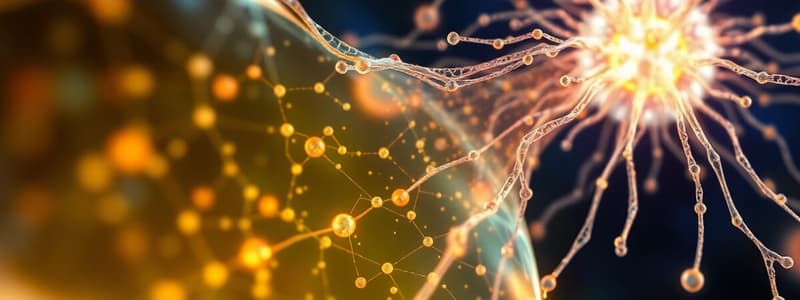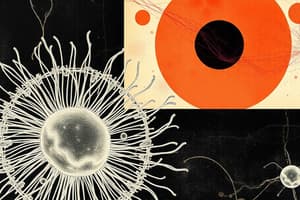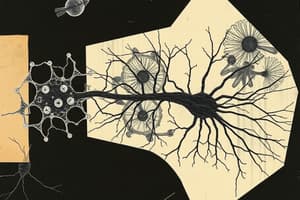Podcast
Questions and Answers
Microtubules grow preferentially at the ______ end.
Microtubules grow preferentially at the ______ end.
plus
Microtubules are nucleated at the ______ end by gamma tubulin ring complexes.
Microtubules are nucleated at the ______ end by gamma tubulin ring complexes.
minus
GTP-hydrolysis controls microtubule ______.
GTP-hydrolysis controls microtubule ______.
stability
MAP 2 and tau regulate microtubule ______.
MAP 2 and tau regulate microtubule ______.
Independent Cdc42 regulation affects both microfilaments and ______.
Independent Cdc42 regulation affects both microfilaments and ______.
Katanin is able to ______ microtubules.
Katanin is able to ______ microtubules.
Microtubule plus-end binding proteins regulate growth and ______ of microtubules.
Microtubule plus-end binding proteins regulate growth and ______ of microtubules.
Free microtubules are present in neuronal cells and ______ cells.
Free microtubules are present in neuronal cells and ______ cells.
What determines the size of the free pool of tubulin in microtubules?
What determines the size of the free pool of tubulin in microtubules?
Which structure is characterized by two centrioles and pericentriolar material?
Which structure is characterized by two centrioles and pericentriolar material?
What role do plus-end binding proteins play in microtubule dynamics?
What role do plus-end binding proteins play in microtubule dynamics?
What mechanism controls the stability of microtubules?
What mechanism controls the stability of microtubules?
What is the primary function of microtubule motors?
What is the primary function of microtubule motors?
What visual technique elucidates the dynamic behavior of individual microtubules?
What visual technique elucidates the dynamic behavior of individual microtubules?
Which of the following best describes the principle of dynamic instability in microtubules?
Which of the following best describes the principle of dynamic instability in microtubules?
What is the role of gamma tubulin ring complexes in microtubules?
What is the role of gamma tubulin ring complexes in microtubules?
Which type of microtubule configuration is characterized by varying numbers of tubulin dimers?
Which type of microtubule configuration is characterized by varying numbers of tubulin dimers?
How do microtubules contribute to cell movement?
How do microtubules contribute to cell movement?
Flashcards
Microtubule Structure
Microtubule Structure
Microtubules are protein polymers formed from tubulin dimers, arranged in singlets, doublets, or triplets. Their spacing is influenced by microtubule-associated proteins.
Microtubule Dynamic Instability
Microtubule Dynamic Instability
Microtubules continuously grow and shrink, fluctuating between polymerization (growth) and depolymerization (shrinkage) at their ends.
Microtubule Plus End
Microtubule Plus End
The end of a microtubule where growth predominates, governed by GTP-hydrolysis.
Microtubule Minus End
Microtubule Minus End
Signup and view all the flashcards
Microtubule Motors
Microtubule Motors
Signup and view all the flashcards
Centrosome Structure
Centrosome Structure
Signup and view all the flashcards
GTP-Cap Regulation
GTP-Cap Regulation
Signup and view all the flashcards
Microtubule Associated Proteins (MAPs)
Microtubule Associated Proteins (MAPs)
Signup and view all the flashcards
Microtubule Singlet
Microtubule Singlet
Signup and view all the flashcards
Microtubule Doublet
Microtubule Doublet
Signup and view all the flashcards
Microtubule Triplet
Microtubule Triplet
Signup and view all the flashcards
Centrosome
Centrosome
Signup and view all the flashcards
Gamma-Tubulin Ring Complex
Gamma-Tubulin Ring Complex
Signup and view all the flashcards
Study Notes
Microtubules: Structure and Function
- Microtubules are found in various cellular locations, exhibiting similar structures.
- Microtubules are composed of α- and β-tubulin dimers, which form protofilaments.
- Protofilaments align to create the hollow microtubule cylinder.
- Microtubules display dynamic instability, alternating between growth and shrinkage phases.
- Microtubules grow preferentially at the plus (+) end and shrink at the minus (-) end.
- Microtubule growth depends on the availability of tubulin subunits and GTP.
- GTP hydrolysis controls microtubule stability.
- Microtubules grow from a microtubule organizing centre (MTOC) such as centrioles.
- The centrosome has two centrioles and pericentriolar material (PCM).
- γ-tubulin ring complexes nucleate microtubule assembly at the minus end.
- Various microtubule-associated proteins (MAPs) influence microtubule stability and spacing, including MAP2 and tau.
- Plus-end binding proteins, such as kinesin and catastrophe factor, regulate microtubule growth and shrinkage.
- Motor proteins like kinesin and dynein move along microtubules, facilitating intracellular transport.
- Kinesin moves towards the plus end, whereas dynein moves towards the minus end.
- Dynein-dynactin complex facilitates minus-end directed motor movement along microtubules.
Microtubules in Cell Processes
- Microtubules are crucial for cell shape and movement, including cilia and flagella function.
- Cilia and flagella are used for propulsion.
- Cilia move materials across cell surfaces.
- Microtubules are essential during mitosis, assisting with chromosome separation.
- Microtubules support the movement of organelles within the cell.
- Microtubules play a critical role in the movement of vesicles.
- Microtubule dynamics are visualized using GFP-EB1 and GFP-tubulin.
- Fluorescence microscopy reveals microtubule growth and shrinkage in vivo.
Studying That Suits You
Use AI to generate personalized quizzes and flashcards to suit your learning preferences.




